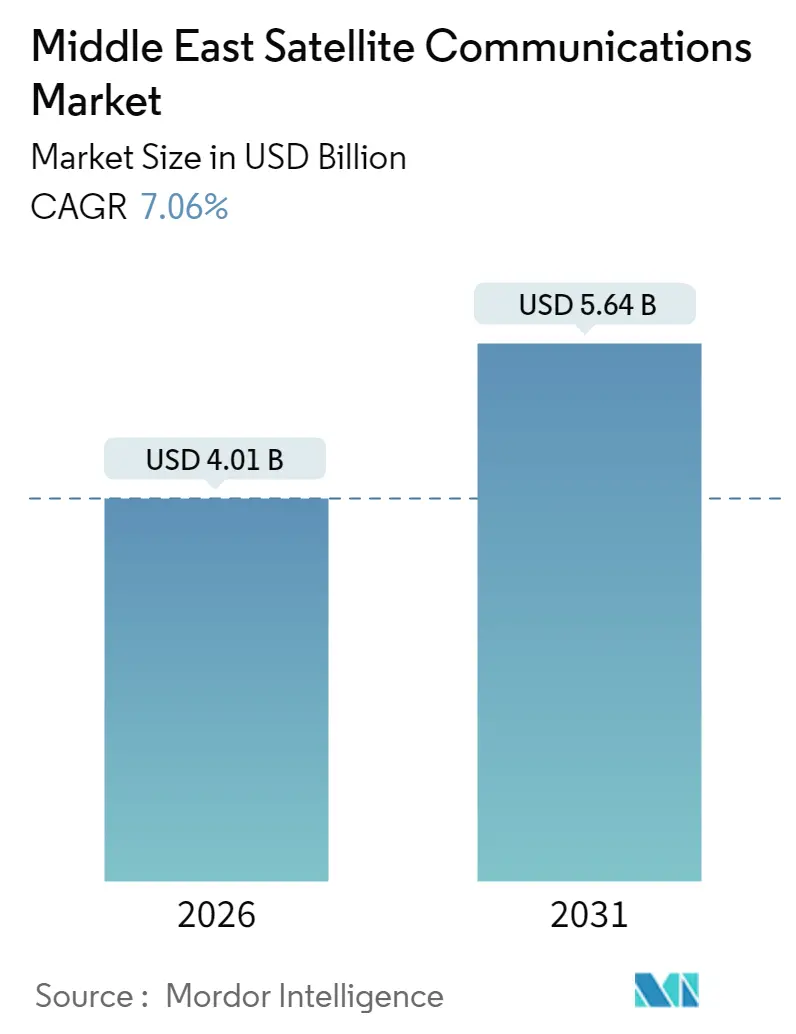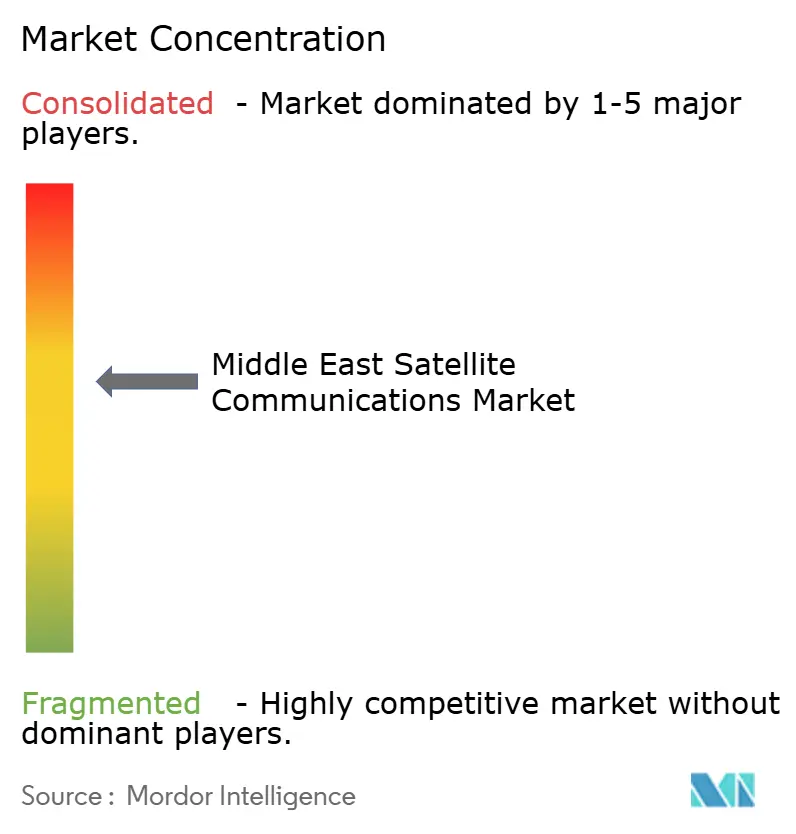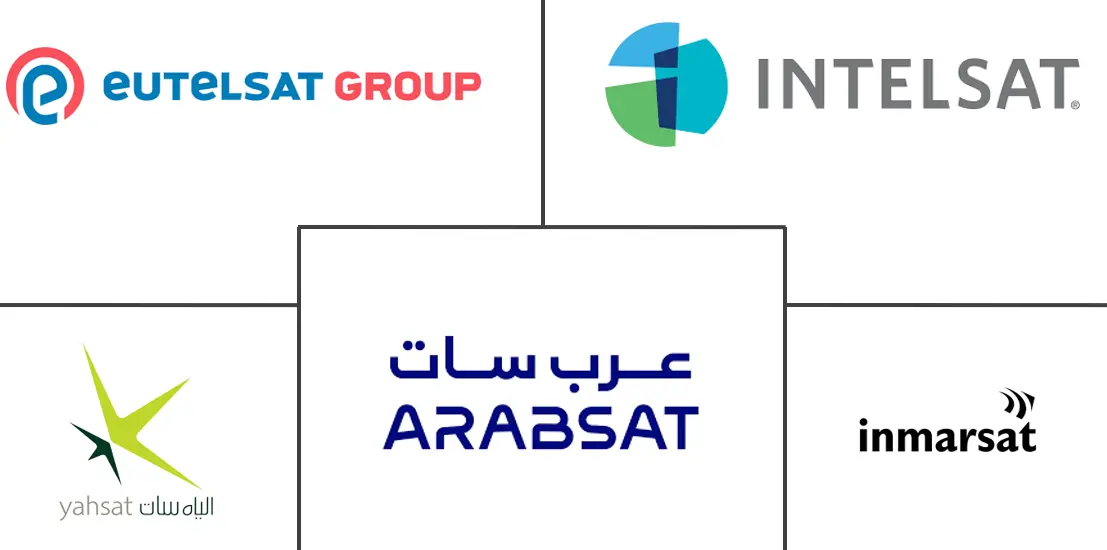Middle East Satellite Communications Market Size and Share

Middle East Satellite Communications Market Analysis by Mordor Intelligence
Middle East satellite communications market size in 2026 is estimated at USD 4.01 billion, growing from 2025 value of USD 3.74 billion with 2031 projections showing USD 5.64 billion, growing at 7.06% CAGR over 2026-2031.[1]Thuraya Press Centre, “Space42's Thuraya 4 Satellite Successfully Launched Into Orbit,” thuraya.com Geopolitical complexities, government‐backed broadband mandates, and a surge of IoT deployments across oilfields, ports, and aircraft are collectively amplifying demand. Operators are prioritizing high-throughput satellite (HTS) investments to meet bandwidth-intensive enterprise and defense needs, even as spectrum coordination challenges raise the cost of new launches. Competitive positioning increasingly hinges on vertically integrated service bundles that blend cloud gateways, managed connectivity, and edge analytics capabilities. Maritime and airborne connectivity, 5G private‐network backhaul, and direct-to-device (D2D) initiatives are emerging as high-margin niches that will shape the next growth wave of the Middle East satellite communications market.
Key Report Takeaways
- By type, ground equipment accounted for 58.05% revenue share of the Middle East satellite communications market in 2025; services are projected to expand at an 7.85% CAGR through 2031.
- By platform, maritime applications commanded 40.30% of the Middle East satellite communications market share in 2025, while airborne platforms are poised for the fastest 8.22% CAGR to 2031.
- By frequency band, Ku-Band retained a 43.30% share of the Middle East satellite communications market in 2025; Ka-Band is set to post an 8.35% CAGR on the strength of HTS rollouts.
- By end-user vertical, defense and government led with 38.75% share of the Middle East satellite communications market in 2025; oil and gas is forecast to register the quickest 8.6% CAGR to 2031.
- By application, data communications held a 46.20% share of the Middle East satellite communications market in 2025 and will advance at an 7.95% CAGR through 2031.
- By country, Saudi Arabia dominated with a 32.05% share of the Middle East satellite communications market in 2025; Qatar shows the steepest 8.7% CAGR potential to 2031.
Note: Market size and forecast figures in this report are generated using Mordor Intelligence’s proprietary estimation framework, updated with the latest available data and insights as of January 2026.
Middle East Satellite Communications Market Trends and Insights
Drivers Impact Analysis
| Driver | (~) % Impact on CAGR Forecast | Geographic Relevance | Impact Timeline |
|---|---|---|---|
| IoT-enabled oilfield equipment uptake | +1.2% | Saudi Arabia, UAE, Kuwait, Qatar | Medium term (2-4 years) |
| Rapid VSAT maritime connectivity adoption | +0.9% | UAE, Saudi Arabia, Oman | Short term (≤2 years) |
| Government universal broadband programs | +1.5% | Saudi Arabia, UAE | Long term (≥4 years) |
| Private inter-satellite relay networks | +0.8% | Global; early gains in UAE, Saudi Arabia | Long term (≥4 years) |
| 5G private-network satellite backhaul | +1.1% | Saudi Arabia, UAE, Qatar | Medium term (2-4 years) |
| Cooperative deep-space GCC missions | +0.4% | UAE, Saudi Arabia, Qatar | Long term (≥4 years) |
| Source: Mordor Intelligence | |||
Increasing Uptake of IoT-Enabled Oilfield Equipment
Thousands of satellite-connected sensors now track pressure, flow, and emissions in remote wells, enabling predictive maintenance and lowering unplanned downtime. Saudi Aramco’s real-time well-monitoring network exemplifies how energy majors leverage space-borne links where fiber is impractical. Space42’s AI-powered analytics further enhance extraction efficiency, while Globalstar’s tank-monitoring tools reduce supply interruptions across Gulf terminals. These deployments cut operating expenses and create recurring bandwidth demand that sustains the Middle East satellite communications market.
Rapid Adoption of VSAT-Based Maritime Connectivity
Major ports in Dubai, Jeddah, and Doha rely on VSAT for vessel traffic management and cargo analytics, driving fleet-wide upgrades by shipping lines. Marlink’s agreements with regional operators showcase how HTS capacity delivers video, IoT telemetry, and crew welfare services.[2]Saudi Telecom Company, “STC and Hughes Network Systems Announce Strategic Partnership,” stc.com.sa Integration with autonomous navigation platforms opens fresh revenue streams as unmanned surface vessels gain regulatory traction.
Government Programs for Universal Broadband (KSA, UAE)
Saudi Arabia’s National Broadband Strategy and the UAE’s Space Strategy 2030 earmark substantial budgets to connect rural communities via satellite backhaul. These long-term, policy-anchored contracts provide predictable cash flows, encouraging operators to localize gateways and strengthen data-sovereignty assurances. National telecom firms are pivoting toward managed satellite services to complement fiber rollouts.
Growth of Private Inter-Satellite Data Relay Networks
Regional operators are adopting optical inter-satellite links that route traffic in space, shrinking latency and mitigating terrestrial choke points. The mesh topology also enhances resilience against ground infrastructure outages, a priority for defense and financial clients. Early investments position the Middle East satellite communications market for secure government cloud and edge-compute workloads.
Restraints Impact Analysis
| Restraint | (~) % Impact on CAGR Forecast | Geographic Relevance | Impact Timeline |
|---|---|---|---|
| Spectrum congestion and cross-border disputes | -0.8% | GCC region | Short term (≤2 years) |
| High CAPEX for HTS fleet upgrades | -1.2% | Regional operators | Medium term (2-4 years) |
| Launch-service export restrictions | -0.6% | Iran; select states | Medium term (2-4 years) |
| Shortage of radiation-hardened chips | -0.4% | Global supply chains | Short term (≤2 years) |
| Source: Mordor Intelligence | |||
Spectrum Congestion and Cross-Border Frequency Disputes
Rapid satellite proliferation has exacerbated interference risks, and ITU coordination procedures struggle to keep pace. Quadsat’s spectrum-monitoring deal with Arabsat signals is growing, and industry recognition that automated tools are vital. Still, unresolved C- and Ku-band overlaps can delay launches and elevate insurance premiums, adding friction to the Middle East satellite communications market.
High CAPEX of HTS Fleet Upgrades
Next-generation satellites cost upward of USD 200 million each, stretching operator balance sheets.[3]Arabsat, “Annual Financial Report 2024,” arabsat.com Yahsat’s recent Airbus orders highlight the financing hurdle, driving reliance on export-credit agencies vulnerable to geopolitical swings. Smaller players risk consolidation if funding options narrow, potentially trimming market diversity.
Segment Analysis
By Type: Services Surge Despite Equipment Dominance
Ground equipment retained a 58.05% share of the Middle East satellite communications market in 2025, anchored by teleport, gateway, and VSAT deployments across Saudi Arabia and the UAE. Yet services revenue is projected to outpace hardware at an 7.85% CAGR, buoyed by managed bandwidth packages, cloud gateways, and satellite-enabled IoT platforms.
Services momentum reflects enterprise appetite for pay-as-you-go models that offload network management overhead. Es’hailSat’s OSS/BSS partnership with neXat exemplifies how automation trims operating costs and accelerates onboarding. As HTS payloads proliferate, operators bundle cybersecurity, edge analytics, and SLA-backed uptime guarantees, expanding wallet share within the Middle East satellite communications market.

Note: Segment shares of all individual segments available upon report purchase
By Platform: Maritime Leadership Challenged by Airborne Growth
Maritime applications accounted for 40.30% of the Middle East satellite communications market share in 2025, due to dense shipping lanes through the Suez Canal and Strait of Hormuz. Airborne connectivity, however, is forecast to post the quickest 8.22% CAGR as airlines race to satisfy passenger streaming expectations and defense UAV fleets scale up.
Regional carriers adopt Ka-Band inflight Wi-Fi to differentiate customer experience, while the UAE’s urban-air-mobility pilots lean on low-latency satellite links for command and control. Land platforms remain critical for oilfield SCADA backups and disaster-recovery networks, reinforcing diverse demand pillars that underpin the Middle East satellite communications market.
By Frequency Band: Ka-Band Challenges Ku-Band Supremacy
Ku-Band held a 43.30% share in 2025, favored for enterprise VPNs and government voice/data services. Ka-Band, though, is projected to grow at 8.35% CAGR as HTS systems unlock higher throughput and smaller user terminals.
Space42’s Thuraya-4, equipped with digital beamforming, illustrates multi-band flexibility that optimizes spectrum allocation. Operators are also eyeing Q/V-Band testbeds, but until ground-segment costs fall, Ku- and Ka-Band will anchor capacity planning across the Middle East satellite communications market.

Note: Segment shares of all individual segments available upon report purchase
By End-User Vertical: Oil and Gas Disrupts Defense Dominance
Defense and government users commanded a 38.75% share in 2025, reinforcing the historic reliance on secure satcom for mission-critical links. Oil and gas, however, will clock a 8.6% CAGR as producers digitize upstream assets and integrate emissions monitoring.
Saudi Aramco’s expansive satellite sensor grid showcases cost savings from predictive maintenance, while QatarEnergy’s offshore rigs adopt HTS to stream seismic data to onshore analytics hubs. Broadening use cases from refinery safety to pipeline surveillance reduce revenue concentration risk and diversify the Middle East satellite communications market.
By Application: Data Communications Maintains Broad Leadership
Data communications held a 46.20% share in 2025 and is poised for an 7.95% CAGR, reflecting enterprise cloud migration and 5G backhaul uptake. Voice traffic continues to taper as OTT apps dominate, while broadcasting retains relevance for pan-Arab television feeds.
Edge computing frameworks paired with satellite gateways support latency-sensitive IoT analytics, expanding managed-service margins. Emerging remote-sensing contracts for agriculture and disaster response further broaden the application mix, cementing data’s central role within the Middle East satellite communications market.
Geography Analysis
Saudi Arabia led with a 32.05% share in 2025, underpinned by Vision 2030 digital targets and vast oilfield networks requiring resilient links. STC’s alliances with Hughes and Intelsat strengthen national coverage and channel rural broadband subsidies into guaranteed capacity leases. Depth of demand across defense, energy, and education cements the kingdom’s scale advantage.
The United Arab Emirates follows as a technology testbed, championing indigenous space capabilities through Space42 and the Mohammed Bin Rashid Space Centre. The National Space Strategy 2030 prioritizes sovereign satcom constellations, incentivizing public-private ventures and export credit support that enlarge the Middle East satellite communications market footprint.
Qatar, although smaller, is projected to accelerate at a 8.7% CAGR to 2031 on the back of satellite procurements aligned with major sports and cultural events. The country’s compact geography enables efficient spot-beam coverage, and sovereign satellite ambitions align with national defense modernization goals.
Turkey’s strategic cross-continental position offers transit-bandwidth demand, while Oman and Kuwait lean on shared GCC capacity pools to extend e-government services to sparsely populated territories. Region-wide, regulatory convergence via the Arab Satellite Communications Organization eases cross-border coordination, though spectrum disputes remain a near-term friction point.
Competitive Landscape
Market consolidation is moderate: regional champions such as Yahsat and Arabsat coexist with global heavyweights like the merged Intelsat-SES entity and Viasat’s post-Inmarsat portfolio. Operators differentiate via capacity scale, sovereign gateway placements, and vertically integrated service stacks that blend cloud hosting with managed connectivity.
White-space opportunities spur collaboration. Space42 and Viasat’s Equatys venture targets direct-to-device messaging and IoT sensor backhaul, bypassing fixed ground gear.[4]Advanced Television, “Space42, Viasat launch Equatys D2D venture,” advanced-television.com Geespace’s USD 281 million funding round for an IoT constellation introduces fresh competitive tension, though regulatory clearances and spectrum filings will dictate rollout velocity.
Capital intensity favors alliances: SES partnering with K2 Space for iterative MEO deployment illustrates risk mitigation via staged launches. Meanwhile, Airbus-Thales-Leonardo’s satellite joint venture negotiations could reshape the hardware supply chain, potentially lowering unit costs for Middle East buyers. Compliance with export controls and ITU filings remains a universal gatekeeper that shapes market entry timelines.
Middle East Satellite Communications Industry Leaders
Al Yah Satellite Communications Company PJSC (Yahsat)
Inmarsat Global Limited (now Viasat Inc.)
Arab Satellite Communications Organization
Intelsat S.A.
Eutelsat Communications S.A.
- *Disclaimer: Major Players sorted in no particular order

Recent Industry Developments
- September 2025: MBRSC signed a cooperation MoU with Colombian agencies, expanding the UAE’s global partnerships.
- September 2025: Es’hailSat showcased teleport capabilities at IBC 2025 to court broadcasters and enterprises.
- September 2025: SES and K2 Space agreed to an iterative MEO deployment model, cutting upfront CAPEX.
- September 2025: Space42 and Viasat unveiled Equatys, a D2D joint venture targeting IoT and mobile markets.
- July 2025: The Intelsat-SES merger closed, creating the world’s largest GEO operator serving the Middle East.
- June 2025: Saudi Arabia formed the Neo Space Group to localize satellite manufacturing under Vision 2030.
- March 2025: Bahrain launched its first domestic satellite, signaling rising regional emphasis on space sovereignty.
- January 2025: SpaceX successfully launched the UAE’s Thuraya-4 satellite, boosting Space42 network capacity.
Middle East Satellite Communications Market Report Scope
Satellite communication is the transfer of data and information via satellites orbiting the Earth. It enables long-distance communication by relaying signals between ground stations and satellite receivers in orbit, enabling television broadcasts, internet access, and phone calls.
The Middle East satellite communications market is segmented by type (ground equipment (satellite gateway, very small aperture terminal (VSAT) equipment, network operation center (NOC), and satellite news gathering (SNG) equipment) and services (mobile satellite services (MSS) and earth observation services)), platform (portable, land, maritime, and airborne), and end-user vertical (maritime, defense & government, enterprise, media & entertainment, and other end-user verticals).
The market sizes and forecasts are provided in terms of value (USD) for all the above segments.
| Ground Equipment | Satellite Gateway |
| VSAT Equipment | |
| Network Operation Center (NOC) | |
| Satellite News Gathering (SNG) Equipment | |
| Services | Mobile Satellite Services (MSS) |
| Earth Observation Services |
| Portable |
| Land |
| Maritime |
| Airborne |
| L-Band |
| C-Band |
| Ku-Band |
| Ka-Band |
| Maritime |
| Defense and Government |
| Enterprises |
| Media and Entertainment |
| Oil and Gas |
| Other End-User Verticals |
| Voice Communications |
| Data Communications |
| Broadcasting |
| Remote Sensing |
| Saudi Arabia |
| United Arab Emirates |
| Qatar |
| Oman |
| Kuwait |
| Turkey |
| Rest of Middle East |
| By Type | Ground Equipment | Satellite Gateway |
| VSAT Equipment | ||
| Network Operation Center (NOC) | ||
| Satellite News Gathering (SNG) Equipment | ||
| Services | Mobile Satellite Services (MSS) | |
| Earth Observation Services | ||
| By Platform | Portable | |
| Land | ||
| Maritime | ||
| Airborne | ||
| By Frequency Band | L-Band | |
| C-Band | ||
| Ku-Band | ||
| Ka-Band | ||
| By End-User Vertical | Maritime | |
| Defense and Government | ||
| Enterprises | ||
| Media and Entertainment | ||
| Oil and Gas | ||
| Other End-User Verticals | ||
| By Application | Voice Communications | |
| Data Communications | ||
| Broadcasting | ||
| Remote Sensing | ||
| By Country | Saudi Arabia | |
| United Arab Emirates | ||
| Qatar | ||
| Oman | ||
| Kuwait | ||
| Turkey | ||
| Rest of Middle East | ||
Key Questions Answered in the Report
How large is the Middle East satellite communications market in 2026?
It is valued at USD 4.01 billion, with a forecast 7.06% CAGR to 2031.
Which platform leads regional demand?
Maritime applications hold 40.30% share due to dense shipping lanes and offshore energy activity.
What segment is growing the fastest?
Airborne connectivity is projected to rise at an 8.22% CAGR as airlines and UAV programs scale.
Which frequency band is gaining ground over the forecast period?
Ka-Band is expected to post an 8.35% CAGR on the back of new HTS deployments.
Why is oil and gas adoption accelerating?
Producers deploy satellite-linked IoT sensors for real-time monitoring, driving a 8.6% CAGR in that vertical.
What is the biggest regulatory hurdle?
Spectrum congestion and cross-border frequency disputes presently subtract about 0.8% from forecast CAGR.



